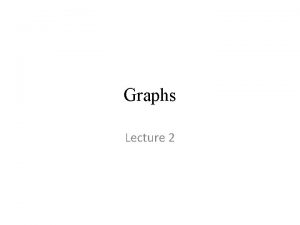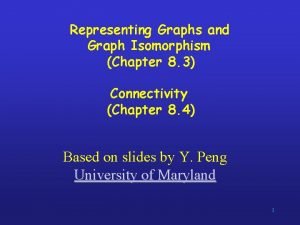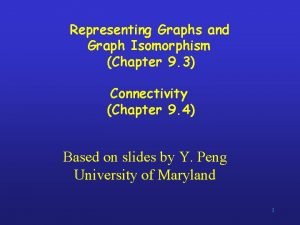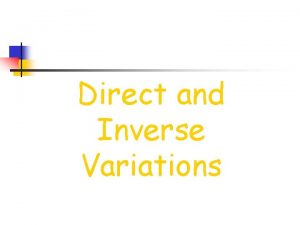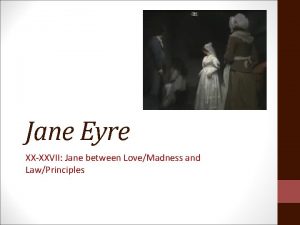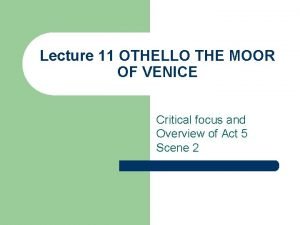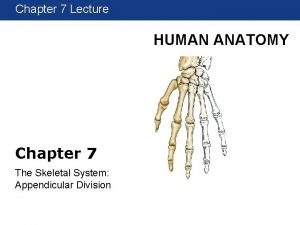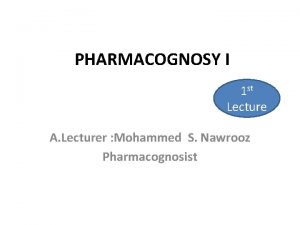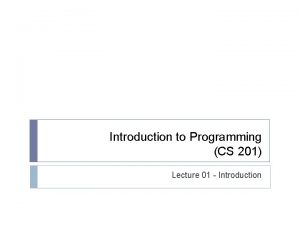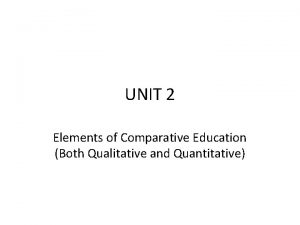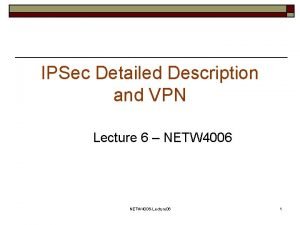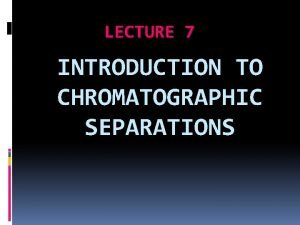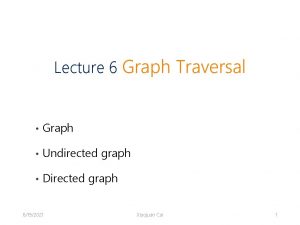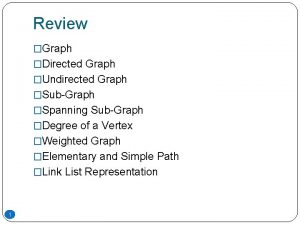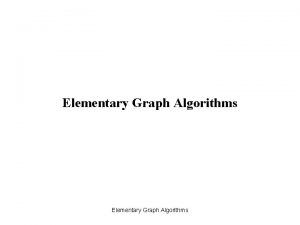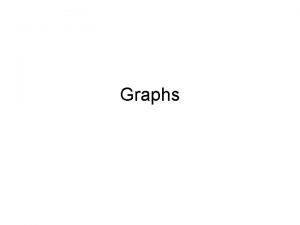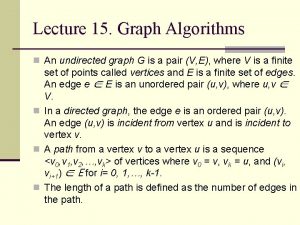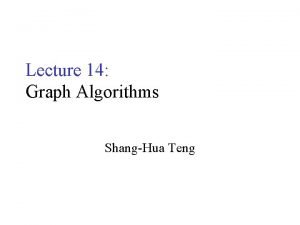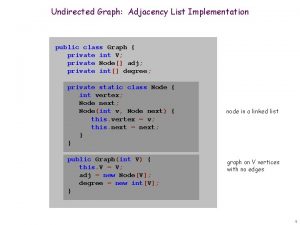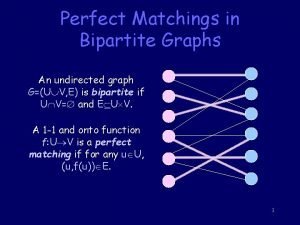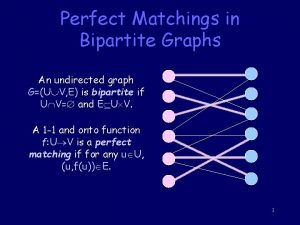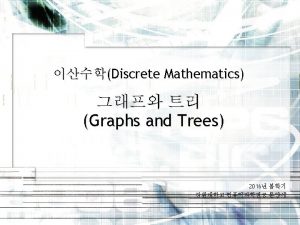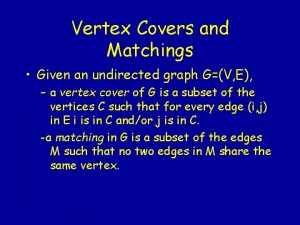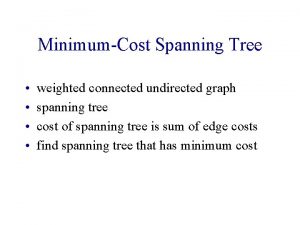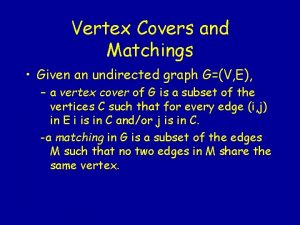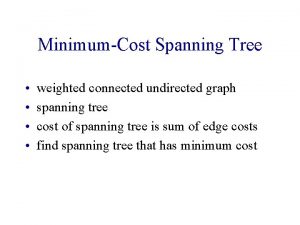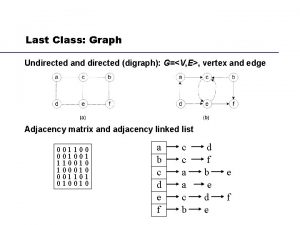Graphs Lecture 2 Graphs 1 An undirected graph




























![Minty’s Lemma 2. 6. (Minty [1960]) Let G be an digraph and e∈E(G). Suppose Minty’s Lemma 2. 6. (Minty [1960]) Let G be an digraph and e∈E(G). Suppose](https://slidetodoc.com/presentation_image/0fb472106c4bbd1dd9924bd965dc2384/image-29.jpg)













- Slides: 42

Graphs Lecture 2

Graphs (1) • An undirected graph is a triple (V, E, Y), where V and E are finite sets and Y: E g{X V : | X |=2}. • A directed graph or digraph is a triple (V, E, Y), where V and E are finite sets and Y : E g{(v, w) V×V : v ≠ w}. • The elements of V are called vertices, the elements of E are the edges. • Two edges e, e' with Y(e) = Y(e') are called parallel. • Graph without parallel edges are called simple.

e={v, w} or e=(v, w) • • In this case v and w are adjacent. v is a neighbor of w (and vice versa). We say that an edge e=(v, w) joins v and w are the endpoints of e. If v is an edpoint of an edge e, we say that v is incident with e. In the directed case we say that (v, w) leaves v and enters w. Two edges which share at least one endpoint are called adjacent.

Underlying undirected graph For a digraph G: the underlying undirected graph is the undirected graph G' on the same vertex set which contains an edge {v, w} for each edge (v, w) of G. We also say that G is an orientation of G'.

Subgraphs • A subgraph of a graph G=(V(G), E(G)) is a graph H=(V(H), E(H)) with V(H) V(G) and V(H) V(G). We also say that G contains H. • H is an induced subgraph of G if it is a subgraph of G and E(H) = {{x, y}| (x, y) E(G) : x, y V(H) }. Here H is the subgraph of G induced by V(H). We also write H=G[V(H)]. • A subgraph H of G is called spanning if V(H) = V(G).

Set of neighbors … • For a graph G and X, Y V(G) we define E(X, Y): ={{x, y} E(G): x XY y YX} E+(X, Y): ={(x, y) E(G): x XY y YX}. • For a graph G and X V(G) we define δ(X): =E(X, V(G) X). The set of neighbors of X is defined by G(X): ={v V(G)X: E(X, {v}) ≠ ø}. • For digraphs G and X V(G) we define δ+(X): =E+(X, V(G) X), δ-(X): = δ+(V(G) X), and δ (X): = δ+(X)∪δ-(X).

The degree of a vertex …(1) For singletons, i. e. one-element vertex sets {v} we write d(v): = d({v}), G(v): = G({v}), d+(v): =d+({v}), d-(v): = d-({v}). The degree of a vertex v is |d(v)|, the number of edges incident to v. In the directed case, the in-degree is |d-(v)|, the out-degree is |d+(v)|, and the degree is |d+(v)|+ |d-(v)|. A vertex v with zero degree is called isolated. A graph where all vertices have degree k is called k-regular.

The degree of a vertex …(2) Lemma 2. 1 For a digraph G and any two sets X, Y⊆V(G): (a)|d+(X)|+|d+(Y)| = |d+(X∩Y)| + |d+(X∪Y)| + |E +(X, Y)|+|E +(Y, X)|; (b)|d-(X)| + |d-(Y)| = |d-(X∩Y)| + |d-(X∪Y)| +|E +(X, Y)| + |E +(Y, X)|. For an undirected graph G and any two sets X, Y⊆V(G): (c) |d(X)|+|d(Y)|=|d(X∩Y)|+|d(X∪Y)|+2|E (X, Y)|; (d) |G(X) |+|G(Y)|=|G(X∩Y)|+|G(X∪Y)|.

Functions A function f : 2 U → R is called • submodular if f(X∩Y)+f(X∪Y) ≤ f(X) + f(Y) for all X, Y⊆U ; • supermodular if f(X∩Y)+f(X∪Y) ≥ f(X) + f(Y) for all X, Y⊆U ; • modular if f(X∩Y)+f(X∪Y) = f(X) + f(Y) for all X, Y⊆U ;

Graphs (3) • A complete graph is a simple undirected graph where each pair of vertices is adjacent. • The complement of a simple undirected graph G is the graph H for which G+H is a complete graph. • A matching in an undirected graph G is a set of pairwise disjoint edges.

Vertex cover, stable set, clique, …(1) • A vertex cover in G is a set S⊆V(G) of vertices such that every edge of G is incident to at least one vertex in S. • An edge cover in G is a set F⊆E(G) of edges such that every vertex of G is incident to at least one edge in F. • A stable set in G is a set of pairwise non-adjacent vertices. • A graph containing no edges is called empty. • A clique is a set of pairwise adjacent vertices.

Vertex cover, stable set, clique, …(2) Proposition 2. 2. Let G be a graph and X⊆V(G). Then the following three statements are equivalent: (a) X is a vertex cover in G, (b) V(G)X is a stable set in G, (c) V(G)X is a clique in the complement of G.

“Minimal” and “minimum” If F is a family of sets or graphs, we say that • F is a minimal element of F if F∈F but no proper subset/subgraph of F, • F is a maximal element of F if F∈F is not a proper subset/subgraph of any element of F. • When we speak of minimum or maximum element we mean one of minimum/maximum cardinality.

Path and cycle • An edge progression W in G is a sequence v 1, e 1, v 2, e 2, …, vk, ek, vk+1 such that k ≥ 0, and ei=(vi, vi+1)∈E(G) for i=1, …, k. • If in addition ei ≠ ej for all 1≤i<j≤ k, W is called a walk in G. • W is closed if v 1= vk+1. • A path is a graph P=({v 1, …, vk+1 }, {e 1, …, ek}) such that vi ≠ vj for 1≤i<j≤ k+1, fand the sequence v 1, e 1, v 2, e 2, …, vk, ek, vk+1 is a walk. • A circuit or a cycle is a graph ({v 1, …, vk }, {e 1, …, ek}) such that the sequence v 1, e 1, v 2, e 2, …, vk, ek, v 1 is a (closed) walk and vi ≠ vj for 1≤i<j≤ k+1. • The length of a path or circuit is the number of its edges.

Hamiltonian graph • A spanning path in G is called a Hamiltonian path. • A spanning circuit in G is called a Hamiltonian circuit or a tour. • A graph containing a Hamiltonian circuit is a Hamiltonian graph.

Distance For two vertices v and w we write dist(v, w) or dist. G(v, w) for the length of a shortest v-w-path (the distance v to w) in G. If the is no v-w-path at all, i. e. w is not reachable from v, we set dist(v, w) = ∞. In the undirected case, dist(v, w)=dist(w, v) for all v, w V (G).

Connected graphs Let G be some undirected graph. G is called connected if there is a v-w-path for all v, w V(G); otherwise G is disconnected. The maximal connected subgraphs of G are its connected components. A vertex v with the property that G – v has more connected components than G is called an articulation vertex. An edge e is called a bridge if G – e has more connected components than G.

Connectivity criterion Proposition 2. 3. a) An undirected graph G is connected if and only if d(X) ≠ ø for all ø ≠ X ⊂V (G). b) Let G be a directed graph and r∈V(G). Then there exists an r-v-path for every v∈V(G) if and only if d+(X) ≠ ø for all X ⊂V (G) with r∈ X.

Proof a) If there is a set X V(G) with r X, v V(G)X, and d(X) = ø there can be no r-v-path G is not connected. Only if: If G is not connected there is no r-v-path for some r and v. Let R be the set of vertices reachable from r. We have r R, v R and d(R) = ø.

Tree, forest, … • An undirected graph without a circuit is called a forest. • A connected forest is a tree. • A vertex of degree 1 in a tree is called a leaf. • A star is a tree where at most one vertex is not a leaf.

Exercise 2. 1 • Prove that forests with n vertices, m edges and p connected components n = m + p holds.

Characterizations of trees Theorem 2. 4. Let G be an undirected graph on n vertices. Then the following statements are equivalent: a) G is a tree (i. e. is connected and no circuits). b) G has n-1 edges and no circuits. c) G has n-1 edges and is connected. d) G is a minimal connected graph (i. e. every edge is a bridge) e) G is a minimal graph with d(X) ≠ ø for all ø ≠ X ⊂V (G). f) G is a maximal circuit-free graph (i. e. the addition of any edge creates a circuit) g) G contains a unique path between any pair of vertices.

Exercise 2. 2 • Prove Theorem 2. 4.

Spanning tree • A spanning tree is a spanning subgraph which is a tree. • In particular, implies that a graph is connected if and only if it contains a spanning tree.

Arborescence • A digraph is called connected if the underlying graph is connected. • A digraph is a branching if the underlying graph is a forest and each vertex v has at most one entering edge. • A connected branching is an arborescence.

Root By Theorem 2. 4 an arborescence with n vertices has n – 1 edges, hence it has exactly one vertex r with d-(r)=ø. This vertex is called a root; we also speak of an arborescence rooted at r. The vertices v with d+(v)=ø are called leaves.

Characterizations of Arborescence Theorem 2. 4. a) b) c) d) e) f) Let G be an undirected graph on n vertices. Then the following statements are equivalent: G is an arborescence rooted at r. G is a branching with n – 1 edges and d-(r)=ø. G has n-1 edges and every vertex is reachable from r but deleting any edge destroys this property. G is a minimal graph with d+(X) ≠ ø for all X⊂V (G) with r∈ X. d-(r)=ø and there is a unique r-v-path for any v∈V (G){r}.

Cuts A cut in an undirected graph G is an edge set of type d(X) for some ø≠X⊂V(G). In a digraph G, d+(X) is a directed cut if ø≠X⊂V(G) and d-(X)=ø, i. e no edges enters the set X. We say that an edge set F⊆E(G) separates two vertices s and t if t is reachable from s in G but not in (V(G), E(G)F). In a digraph, an edge set d+(X) with s∈X and t ∉X is called an s-t-cut. An s-t-cut in an undirected graph is a cut d(X) for some X⊂V(G) with s∈X and t ∉X. An r-cut in a digraph is an edge set d+(X) for some X⊂V(G) with r∈X.
![Mintys Lemma 2 6 Minty 1960 Let G be an digraph and eEG Suppose Minty’s Lemma 2. 6. (Minty [1960]) Let G be an digraph and e∈E(G). Suppose](https://slidetodoc.com/presentation_image/0fb472106c4bbd1dd9924bd965dc2384/image-29.jpg)
Minty’s Lemma 2. 6. (Minty [1960]) Let G be an digraph and e∈E(G). Suppose e is colored black, while all other edges are colored red, black or green. Then exactly one of the following statements holds: a) There is an undirected circuit containing e and only red and black edges such that all black edges have the same orientation. b) There is an undirected cut containing e and only green and black edges such that all black edges have the same orientation.

Proof Let e= (x, y). We label the vertices of G by the following procedure. • First label y. • In case v is already labeled and w is not, we label w if there is a black edge (v, w), a red edge (v, w) or a red edge (w, v). In this case, we write pred(w) = v. When the labeling procedure stops, there are two possibilities.

Example y x

x has been labeled y x

x has not been labeled y x

Either cycle or cut y x ?

Strongly connected digraph(1) • A digraph is called strongly connected if there is a path from s to t and a path from t to s for all s, t ∈V(G). • The strongly connected components of a digraph are the maximal strongly connected subgraphs.

Strongly connected digraph(2) Corollary 2. 7. In a digraph G, each edge belongs either to a (directed) circuit or to a directed cut. Moreover the following statements are equivalent: a) G is strongly connected. b) G contains no directed cut. c) G is connected and each edge of G belongs to a circuit.

Proof с) a) • Let r V(G) be an arbitrary vertex. We prove that the is an r-v-path for each v V(G). • Suppose this is not true, then by Proposition 2. 3(b) there is some X V(G) with r X and d+(X)=ø. • Since G is connected, we have d+(X) ⋃ d–(X) ≠ ø (by Prop 2. 3 a)), so let e d–(X). But then e cannot belong to a circuit since no edge leaves X.

Acyclic digraph A digraph is called acyclic if it contains no (directed) circuit. So by Corollary 2. 7 a digraph is acyclic if and only if each edge belongs to a directed cut. Moreover, a digraph is acyclic if and only if its strongly connected component are singletons.

Topological Order • Definition 2. 23. Let G be a digraph. A topological order of G is an order of the vertices V(G)={v 1, …, vn } such that for each edge (vi , vj) E(G) we have i < j. • Proposition 2. 3. A digraph has a topological order if and only if it is acyclic.

Proof • If a digraph has a circuit, it clearly cannot have a topological order. • We show the converse by induction on the number of edges. • If there are no edges, every order is topological. • Otherwise, let e∈E(G); by Corollary 2. 7 e belongs to a directed cut d+(X). • Then a topological order of G[X] followed by a topological order of G −X is a topological order of G.

Exercises 2. 3 and 2. 4 2. 3. Let G be a simple undirected graph. Show that G or its complement is connected. 2. 4. Show that any undirected graph has a cut containing at least half of the edges.

Homework • Let G be an undirected graph, and let (V(G), F 1) and (V(G), F 2) be two forests in G with |F 1| < |F 2|. • Prove that there exists an edge e ∈ F 2F 1 such that (V(G), F 1 ⋃{e}) is a forest.
 Undirected graph algorithms
Undirected graph algorithms ファイルメーカー グラフ
ファイルメーカー グラフ Underlying undirected graph
Underlying undirected graph Contoh graf sederhana
Contoh graf sederhana Single-source shortest paths
Single-source shortest paths 01:640:244 lecture notes - lecture 15: plat, idah, farad
01:640:244 lecture notes - lecture 15: plat, idah, farad Graph neural network lecture
Graph neural network lecture 5-3 polynomial functions
5-3 polynomial functions Transition bugs in software testing
Transition bugs in software testing Graphs that compare distance and time are called
Graphs that compare distance and time are called Graphs that enlighten and graphs that deceive
Graphs that enlighten and graphs that deceive Representing graphs and graph isomorphism
Representing graphs and graph isomorphism Representing graphs and graph isomorphism
Representing graphs and graph isomorphism Euler
Euler Inverse variation graph
Inverse variation graph Algorithmic graph theory and perfect graphs
Algorithmic graph theory and perfect graphs Handshaking theorem
Handshaking theorem Resource allocation graph and wait for graph
Resource allocation graph and wait for graph Drawing lecture
Drawing lecture Jane_ixx
Jane_ixx Othello lecture
Othello lecture Lecture vegetable
Lecture vegetable In text citation for a lecture
In text citation for a lecture Data visualization lecture
Data visualization lecture Data mining lecture notes
Data mining lecture notes Sltpttch
Sltpttch Physics 241 purdue
Physics 241 purdue Molecular biology lectures
Molecular biology lectures Define pharmacognosy
Define pharmacognosy Eurocode 2 lap length table
Eurocode 2 lap length table Cs201 lecture 1
Cs201 lecture 1 Demonstration method of teaching
Demonstration method of teaching Vpn lecture
Vpn lecture Network management principles
Network management principles Exploratory data analysis lecture notes
Exploratory data analysis lecture notes La capture d'antigone
La capture d'antigone Risk management lecture
Risk management lecture Atomic emission spectroscopy lecture notes
Atomic emission spectroscopy lecture notes Reservoir and channel routing
Reservoir and channel routing Life lecture meaning
Life lecture meaning Isa computer architecture
Isa computer architecture Chromatography lecture
Chromatography lecture Power system dynamics and stability lecture notes
Power system dynamics and stability lecture notes


